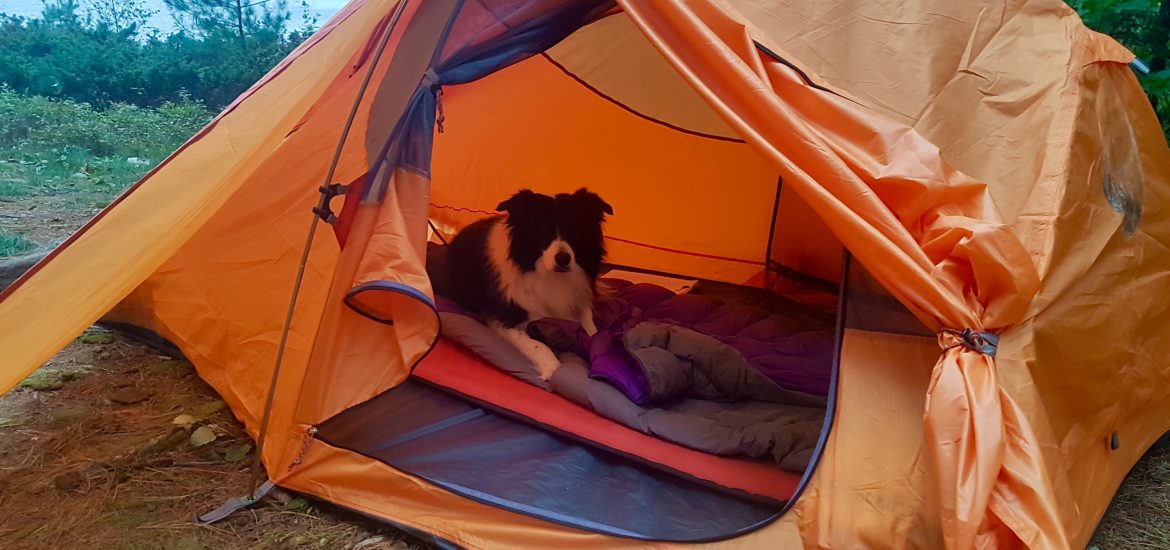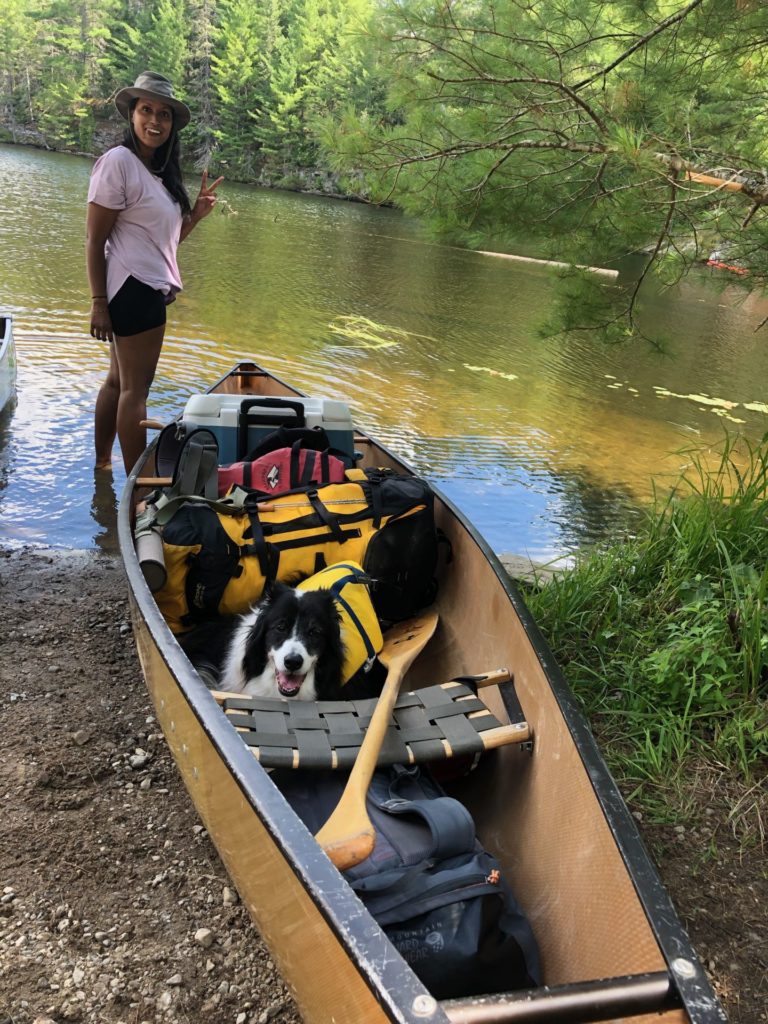If you’re like me, camping with your dog is one of the best ways to spend time in nature.
But, if you’re new to camping or it’s your dogs first camping trip, you might wonder where exactly will your dog be sleeping? And, can your dog sleep inside of a tent with you?
Although it’s entirely normal and acceptable for your dog to sleep inside a tent with you, there are a two major things to consider:
- An anxious or unprepared dog can damage a tent if forced inside.
- Bugs and insects might be brought inside your tent unknowingly by a dog.
So, let’s review how to train and get your dog calm and comfortable to sleep in a tent.
How to Train a Dog to Sleep in a Tent
Understanding Dog Behaviour
Camping, especially for a dog, can be such an exciting and different experience. All the new sites, smells, sounds, and especially the sticks!
But, with so many new and distracting things, sleeping in a tent might prove to be somewhat difficult. The confined space, limited view, rattling of the poles, or even the new smell, can agitate some dogs.
- Perhaps feeling trapped inside, a dog may attempt to scratch, dig or bite their way out of a tent, causing damage.
- A dog may even become nervous and excessively drool or urinate inside if their anxiety level rises.
How I Trained My Dog
Personally, I have a very skittish border collie named Shilo and I was worried she would have a negative reaction to sleeping in a tent.
So, before leaving for our first camping trip, I made sure my dog was completely comfortable with being inside of a tent.
First, in my living room, I set up my (small) backpacking tent while she watched. I made sure to keep all the tent doors open and tied up.
- I gently encouraged Shilo to smell the outside of the tent by herself.
- I sat inside and encouraged her to walk around on the inside.
- When she was comfortable enough to sit and lay down on the inside I slowly zipped up the doors.
I then setup my tent in the backyard and repeated the process.
- Sometimes I would stand outside of the door and tell her to go inside before I entered.
- This proved to be super helpful at night while camping.
I also progressively shook the tent while inside with her to simulate windy conditions.
All this preparation proved to work wonders. So far, my dog has been able to sleep peacefully inside our tent, even through severe rain and windstorms!

Dog Precautions Inside a Tent
Bugs & Insects
Dogs can unwittingly carry bugs and insects inside of your tent. Some bugs may be benign and harmless whereas others can pose a significant risk to you and your dog’s health.
Ticks
Depending on where you camp, ticks can be a serious concern for dogs. Ticks can attach to a dog’s fur and eventually lead to a bite.
Ticks are feared because some species, in particular the black-legged or deer tick, carry Lyme disease [Reference].
- In dogs, Lyme disease can cause fever, lameness and stiffness, and can progress to kidney failure, which can be fatal.
Long term symptoms in humans include joint pain, hepatitis, and neurological problems.
Mosquitos & Black-flies
Depending on the time of the year, mosquitos and blackflies can be absolutely relentless and wreck havoc on your camping trip.
- Viruses like West Nile and eastern equine encephalitis as well as canine heartworm are passed along by mosquitos.
In North America, black flies are not known to transmit any diseases [Reference], however their bites can leave a welt and may itch for several days.
Pro-tip: Check out How Stop Mosquito Bites for more helpful infomation.
Spiders and Ants
The bite of certain species of spiders and ants can be quite painful for both dogs and humans.
Although not fatal, these bites can be extremely uncomfortable and may require medication attention.
Bug Prevention and Protection
Needless to say ticks, mosquitos and other insects are nasty critters. So, be sure to administer your dog’s tick medication before camping to ensure they don’t get bit.
DEET and other mosquito repellents specifically made for humans can be dangerous and harmful for dogs [Reference]. Instead, only use vet-approved repellents.
And, if the bugs are particularly intense, consider keeping your dog inside a screen house or in your tent to prevent them from getting swarmed.
- Before entering a tent, quickly comb your dog’s fur either with a brush or by hand to shake off any trapped insects.
This should help prevent them from making their way inside of your tent.
Damage to Tent Base
A dog with particularly long or sharp nails may inadvertently puncture the bottom fabric of your tent.
In wet conditions, this can cause water to leak into your tent, but it’s entirely fixable!
Pro-tip: If you tent does get tore or punctured by your dog, check out How to Fix a Damaged Tent.
So, to help prevent punctures or tears, cut or trim your dog’s nails before camping.
Additionally, you can place a tarp inside of your tent to act as a sacrificial barrier.
Pro-tip: For specific information about tarps, check out The Best Tarps for Camping.
Bring the Right Chew Toys
Whenever you camp, it’s best practice to never bring food or scented items inside of your tent. The same can be said for dogs.
- Doggy bones and edible chew toys such as hides should not be brought inside of a tent.
- They can attract smaller rodents as well as larger animals such as raccoons and even bears.
Inside, bring non-edible chew toys made from plastic, rubber or nylon. These toys are neutral-scented and you won’t need to worry about them attracting animals or insects!

Helpful Gear for Dogs When Camping
Towel
If the weather is unsettled, bringing a towel to dry off your dog and clean their paws is a great way to minimize odors inside of a tent.
Likewise, a dry dog will be much warmer at night and sleep comfortably.
Comb
Combing your dog’s coat just before entering a tent can help prevent bugs and insects from tracking inside.
Be sure to focus on the underbelly and legs, since those areas are the most likely to contain ticks and insects.
Dog Blanket or Bed
Sleeping directly on the ground in a tent can be uncomfortable. Dogs can be exposed to rocks and roots and, depending on the time of the year, the cold.
So, to make their nights comfy, consider bringing a portable dog sleeping pad or a small blanket. This can help keep dirt and hair from going everywhere, and keep them warm at night.
This article contains affiliate links, which help support this blog at no cost to you!

Pingback: How to Properly Set Up a Tarp for Rain or Shade [Over a Picnic Table]
Pingback: How Much Firewood Do You Need for Camping? Wood Types and Burn Rate Explained
Pingback: How Much Firewood Is (Actually) Needed For Camping? A Helpful Guide!